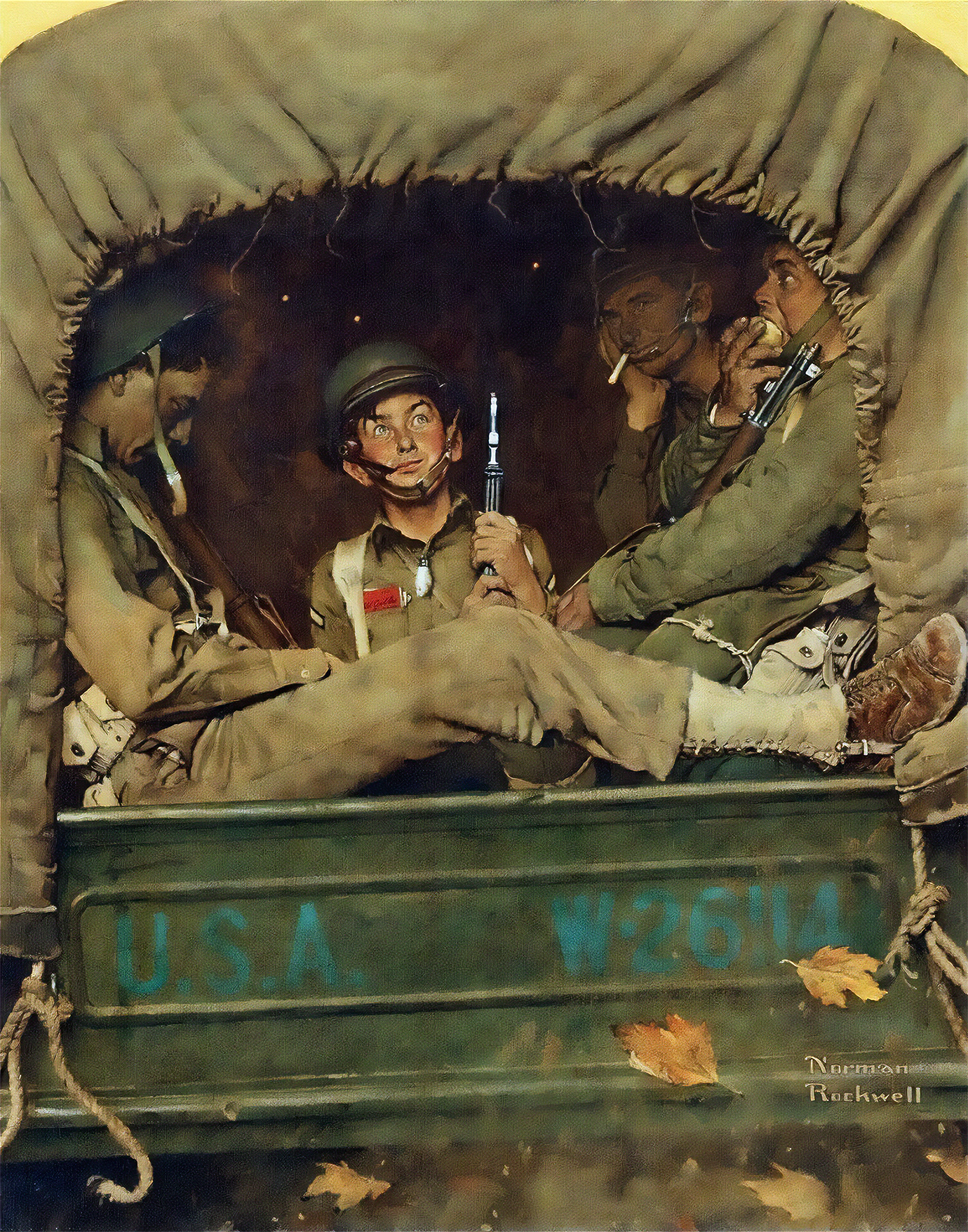Willie Gillis in Convoy

About the Painting – This is the actual text from Sotheby’s
- Norman Rockwell
- Willie Gillis in Convoy
- signed Norman Rockwell (lower right)
- oil on canvas
- 43 by 34 1/4 inches
- (109.2 by 87 cm)
- Painted in 1941.
The first cover of The Saturday Evening Post featuring Norman Rockwell’s fictional soldier, Willie Gillis, was published on October 4, 1941. Over the next five years, Rockwell painted eleven Post covers featuring Gillis and his adventures serving in the armed forces during the Second World War. “I had conceived of the idea of a series of Post covers depicting the army experiences of a young civilian,” the artist later recalled of the character, “sort of an innocent fellow who suddenly found himself caught up in a completely strange life” (Norman Rockwell, My Adventures as an Illustrator, New York, 1994, pp. 326-27). Rockwell asked Robert Otis Buck, a local Arlington, Vermont boy whom he had spotted at a square dance, to be his model. Buck had the fresh-faced innocent look Rockwell wanted for the part of Gillis and had been exempted from the draft, which meant he would be around long enough for Rockwell to complete the series he was planning on the life of a soldier. It was Rockwell’s wife, Mary, who invented the name Willie Gillis, after a character named Wee Gillis in a book she had read to their children.
In his classic manner, Rockwell used the character of Willie Gillis to project a comforting vision of the world, even in the face of a global war. Unlike many of his contemporaries, he largely chose to render scenes that alluded to, but never explicitly depicted combat. “Most of the pictures I did during the war took their subjects from the civilian wartime scene—the armchair general, women war workers, the ration boards,” he wrote of his work of this period. “That was what I knew about and what I painted best” (Rockwell, p. 328).
Although the imagery of Willie Gillis in Convoy portrays the war more explicitly than others in the series, its reference to actual battle remains oblique and speaks more to the everyday experiences of a soldier’s life in the army. In the present painting, Rockwell depicts Gillis in the back of a transport truck along with several of his comrades. Rockwell uses an acute attention to naturalistic detail to enhance the narrative undertones of the work. The cloud of dust and leaves swirling in the foreground indicate that the truck is in motion. Nestled in the hold, the soldiers appear to have been traveling for some time: some of the men enjoy a brief nap or a bite to eat, while others look contemplatively into the distance. Only the hero of the story, Gillis—armed with his lucky rabbit’s foot—remains alert with wide eyes and a rigid posture, ready to meet the enemy whenever he should present himself.
When Willie Gillis in Convoy was submitted for review, Rockwell’s Post editors praised it for the painterly qualities it displayed, but it ultimately never appeared on the cover of the publication. The work remained in Rockwell’s Arlington studio until 1951, when F. Earl Williams, the principal of Gardner High School in Gardner, Massachusetts paid Rockwell a visit. Williams, an acquaintance of the artist, came with the intention of purchasing an original Rockwell that the 1951 graduating class could give to the school. The painter, whose popularity was reaching its apex in the 1950s, initially told Williams that he likely could not afford the purchase. In fact, he said he had become so busy in recent years that he no longer had time to make a trip to town to mail a letter. Seeing the unsent envelope to which Rockwell was referring, Mr. Williams offered to mail the letter himself. This act of kindness prompted the artist to offer a tour of his studio, where he showed Mr. Williams Willie Gillis in Convoy. According the school’s history, Rockwell asked Mr. Williams what he thought of the painting as they stood in front of it. His response—unfortunately unknown today—surprised Rockwell, who felt he had never before heard someone perfectly understand what he was trying to express with the work. As a gesture of gratitude, Rockwell donated the painting to Gardner High School, where it hung in the principal’s office for many years.
